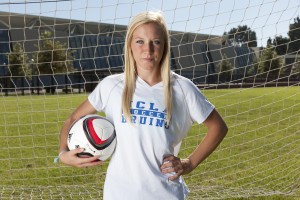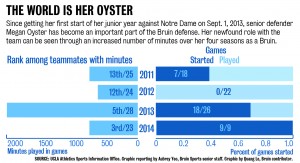It was during a pregame meeting last year, before UCLA’s game at Notre Dame, when Megan Oyster saw something that made her heart skip a beat.
Right there on the board inside the locker room, under one of two starting center back positions, was Oyster’s name. Even with the game just moments away, the first thing the then-junior did was grab her phone. She made sure her friends and family who had made the 100-mile journey from Chicago wouldn’t have to wait until the starting lineup announcements to find out the good news.
Megan Oyster didn’t just start the game, however, she played the full 90 minutes.
Even as a consistent starter having begun all nine of UCLA’s games thus far, and one of the leaders on the team in terms of minutes played, that first start Oyster received in her junior season still bears significance.
“That was the start of it all. I remember going into each game trying to look back at the Notre Dame game thinking, ‘I don’t want to give up this spot, I earned it, I worked for it and now it’s mine to lose,’” Megan Oyster said.
***
At first, it appeared as if 2013 could be the year for Oyster to rise to prominence.
“I felt good going into my junior year; I felt like I had a lot of experience. Throughout preseason, I was playing well,” Megan Oyster said.
But with a talented UCLA team filled with players performing at high levels as well, Oyster’s time would have to wait.
One reason was then-freshman Gabbi Miranda. Fresh off a successful stint with the U.S. Under-20 Women’s National team before the start of the 2013 season, Miranda was given the starting center back job over Oyster.
Spurred on by her teammates and team staff members, Oyster continued to work on the weaknesses that were in the way of her becoming an elite center back in UCLA’s starting 11.
Playing better with her left foot, playing quicker and more straightforward – those were aspects of Oyster’s game she knew she had to work on. But coach Amanda Cromwell believes it was better conditioning that opened up Oyster’s game.
“She can (now) play 90 minutes, make runs forward, not having worries about running out of gas,” Cromwell said. “She has a lot of confidence, I think, because of that.”
After the successful audition against Notre Dame, where the Bruin back line managed to hold the then-No. 7 Fighting Irish to just one shot attempt, Oyster finally cemented her spot as one half of UCLA’s starting center back duo alongside then-junior Abby Dahlkemper.
But that wasn’t the first time Oyster was forced to adapt in order to continue playing the game she loved.
***
From the young age of six, Oyster began to stand out amongst her peers as a forward for the Windy City Pride Soccer Club in Chicago. So much so, that coach Ko Thanadabouth thought she might benefit playing at a higher level compared to other girls her age.
“My club coach’s (Thanadabouth’s) idea was to put me on the boys’ team and allow me to grow as a player more so than I would in a girls’ league,” Oyster said.

The emphasis on physicality and the quicker pace of the boy’s league became things that Oyster had to learn to compensate with in order to remain competitive.
And under this new environment, a young Oyster’s soccer skills continued to flourish, in particular her strength and in-game focus.
“It helped her make decisions faster, helped slow the women’s game down for her to be able to play against guys on a consistent basis,” said Sue Soderberg, Oyster’s assistant coach at Neuqua Valley High School.
***
One thing stuck out to Bryan Oyster as he brought his daughter to the local Olympic Development Program to begin her pursuit for a spot on the national team.
“There were a million forwards,” he said.
Not content with sitting on the bench, and knowing full well that any chance of playing for her country rode on getting exposure within the program, Megan Oyster took a chance.
“I stepped up and just said ‘I’ll try center back,’” she said.
Oyster became a natural in her new position. It didn’t take long for Oyster to become a mainstay on her regional team and grab the attention of national coaches by the age of 15, eventually becoming a part of the national team up to the Under-20 level.
At the high school level, Oyster made the permanent transition to center back her junior year and started to become a new weapon for the Neuqua Valley High School Wildcats. By her senior year, Soderberg was confident enough in Oyster’s ability to anchor the defense that the team was free to experiment with a new formation that only utilized three defenders as opposed to the typical four.
“You want somebody like that at the back,” Soderburg said. “The kids that were playing in front of her in midfield were always confident knowing that Megan was behind them, A: directing them, and B: there to clean up anything that got through.”
The little things she picked up along her journey would come in handy during the most important game of her soccer career – playing for a national championship with UCLA.
***
“(Watching her play for a national championship) to me was just electric. It was just so much fun. It could’ve been one of the best experiences of my life,” Bryan Oyster said of his experience in Cary, N.C. last year.
After a nail-biting win over the Virginia Cavaliers that was decided by a penalty shootout, a familiar face decided to pay the Oysters a visit.
Thanadabouth, who traveled to North Carolina and watched the semi-final match, told Megan Oyster that even though she played a great game on defense against the nation’s No. 1-ranked offense, he knew she still had more in her.
“’I need you to do more things; I need you to make a run once in a while because I know you can do it; you’ve done it all your life,’” Bryan Oyster recalls Thanadabouth telling his daughter.
Two days later, it was time for the final test of the season. Six minutes into overtime in the championship game, Thanadabouth’s words started to hold some weight.
“When Megan starts going up the field, the panic sets in,” Bryan Oyster said. “We’re like, ‘What is she doing? What is she doing?’”
She was setting up the goal that would win her team a national championship.
The Bruin sideline started shuffling to get a better view of the action as Megan Oyster weaved through one Florida State player after another.
“I definitely think that is an advantage of me playing forward as a kid. I kinda know what a forward would think in situations,” she said. “So the run (junior forward) Kodi (Lavrusky) made, I had an idea she was going to run across and behind the defenders.”
A well-executed pass from Megan Oyster slipped past three Seminole defenders into the feet of Lavrusky, allowing her teammate to score the golden goal for UCLA.
It was a play that Cromwell said the Bruins “talked about (running) all the time,” but often struggled to perfectly execute. And at that one moment, it seemed like all the cards were in alignment.
“For a center back to come forward and get the game winning assist, that’s huge,” Cromwell said. “I love the fact that both (Oyster and Lavrusky) were not starters at the beginning of the year, and they combined and got us the goal that won us a national championship.”
***
Now in her final season at UCLA, Megan Oyster and the rest of the Bruin back four have continued to build upon their reputation as one of the best defenses in the country with a goals allowed average of 0.217 that ranks No. 4 in the nation.
Although Oyster and senior defender Abby Dahlkemper may be the anchors as the last line of defense in front of the goalkeeper, a more underrated aspect of their game is how they also can form the starting points of the UCLA offense.
“They both have the green light to go forward. I think Megan does it more naturally, she definitely fancies herself an attacking player and she wants to get up there and score goals,” Cromwell said.
As a perennial header target in Bruin set-pieces, Oyster will continue to get a fair share of attempts to hit the back of the net. In fact, it only took 26 minutes into the 2014 season for Oyster to score UCLA’s first goal.
But her coach knows that with plenty of games left in the season, Oyster’s not just going to stop there.
“She already has one goal off a header,” Cromwell said. “She needs more.”

